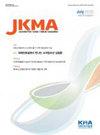日本远程医疗的现状:对韩国的启示
IF 0.5
Q3 MEDICINE, GENERAL & INTERNAL
引用次数: 0
摘要
背景:自2019冠状病毒病爆发以来,远程医疗已成为全球提供医疗服务的重要手段。本研究旨在强调在韩国建立远程医疗政策的意义。日本的远程医疗政策从第一次试行到目前的官方补贴都进行了审查。当前概念:自1971年开始远程医疗示范工作以来,日本的远程医疗发展经历了四个阶段。第一阶段是1971 - 1997年远程区域综合医疗信息系统的运行。第二阶段是1997年至2018年远程医疗正式制度化。第三个阶段是远程医疗的扩张时期,从2018年发布《正确在线医疗实施指南》到2020年暂时允许在线首次检查。第四阶段始于2021年,宣布“在线医疗专项常设设置”,远程医疗正式被允许作为面对面医疗的补充。2021年远程医疗的使用估计约为5365万,2021年日本的治疗总数估计约为13.2亿,约占医疗保健的4.1%。讨论与结论:韩国政府要建立远程医疗,需要通过与医疗界的讨论,逐步推进。另外,为了确保远程医疗的安全性,需要制定适当的医疗报酬制度和反映医疗界意见的指导方针。本文章由计算机程序翻译,如有差异,请以英文原文为准。
Current status of telemedicine in Japan: implications for Korea
Background: Since the coronavirus disease 2019 outbreak, telemedicine has become an important means of providing medical care worldwide. This study aims to highlight the implications of establishing telemedicine policies in Korea. Japan’s telemedicine policies were reviewed from the time of the first trial to the present official allowance.Current Concepts: Since telemedicine demonstration work began in 1971, telemedicine in Japan has advanced in four stages. The first stage was the operation of a remote regional comprehensive medical information system from 1971 to 1997. The second stage was when telemedicine was officially institutionalized from 1997 to 2018. The third stage was the time of expansion of telemedicine, from the announcement of the “Guidelines for the Implementation of Proper Online Care” in 2018 to when online first-time examinations were temporarily allowed in 2020. The fourth stage began in 2021 when the “Permanent Establishment of Special Cases for Online Care” was announced, and telemedicine has been officially allowed to supplement face-to-face care. Telemedicine usage was estimated to be about 53.65 million in 2021, and the total number of treatments in Japan in 2021 was estimated to be about 1.32 billion, accounting for about 4.1% of medical care.Discussion and Conclusion: For the Korean government to establish telemedicine, it needs to be promoted step by step through discussions with the medical community. Also, an appropriate medical remuneration system needs to be prepared along with guidelines reflecting the opinions of the medical community to secure the safety of telemedicine.
求助全文
通过发布文献求助,成功后即可免费获取论文全文。
去求助
来源期刊

Journal of The Korean Medical Association
Medicine-General Medicine
CiteScore
0.50
自引率
0.00%
发文量
84
审稿时长
4-8 weeks
期刊介绍:
The Journal of the Korean Medical Association (JKMA) is the official peer-reviewed, open-access, monthly journal of the Korean Medical Association (KMA). It contains articles in Korean or English. Its abbreviated title is ''J Korean Med Assoc''. The aims of the Journal include contributing to the treatment of and preventing diseases of public health importance and to improvement of health and quality of life through sharing the state-of the-art scientific information on medicine by the members of KMA and other national and international societies.
 求助内容:
求助内容: 应助结果提醒方式:
应助结果提醒方式:


